Dell P21L, JD925 User Manual
Dell™ Latitude™ 120L
Quick Reference Guide
Model PP21L
w w w . d e l l . c o m | s u p p o r t . d e l l . c o m

For information on other documentation included with your computer, see "Finding Information" on page 5.
Notes, Notices, and Cautions
NOTE: A NOTE indicates important information that helps you make better use of your computer.
NOTICE: A NOTICE indicates either potential damage to hardware or loss of data and tells you how to avoid the problem.
 CAUTION: A CAUTION indicates a potential for property damage, personal injury, or death.
CAUTION: A CAUTION indicates a potential for property damage, personal injury, or death.
Abbreviations and Acronyms
For a complete list of abbreviations and acronyms, see the Glossary in your computer User’s Guide.
If you purchased a Dell™ n Series computer, any references in this document to Microsoft® Windows® operating systems are not applicable.
____________________
Information in this document is subject to change without notice. © 2005 Dell Inc. All rights reserved.
Reproduction in any manner whatsoever without the written permission of Dell Inc. is strictly forbidden.
Trademarks used in this text: Dell, the DELL logo, and Latitude are trademarks of Dell Inc.; Microsoft and Windows are registered trademarks of Microsoft Corporation; Intel and Pentium are registered trademarks of Intel Corporation.
Other trademarks and trade names may be used in this document to refer to either the entities claiming the marks and names or their products. Dell Inc. disclaims any proprietary interest in trademarks and trade names other than its own.
Model PP21L
December 2005 |
P/N JD925 Rev. A00 |

Contents
Finding Information . . . . . . . . . . . . . . . . . . . . . . . . . . . . . . . . |
5 |
Setting Up Your Computer . . . . . . . . . . . . . . . . . . . . . . . . . . . . . |
8 |
About Your Computer. . . . . . . . . . . . . . . . . . . . . . . . . . . . . . . . |
9 |
Front View. . . . . . . . . . . . . . . . . . . . . . . . . . . . . . . . . . . |
9 |
Left Side View . . . . . . . . . . . . . . . . . . . . . . . . . . . . . . . . |
10 |
Right Side View . . . . . . . . . . . . . . . . . . . . . . . . . . . . . . . |
10 |
Back View. . . . . . . . . . . . . . . . . . . . . . . . . . . . . . . . . . |
10 |
Bottom View . . . . . . . . . . . . . . . . . . . . . . . . . . . . . . . . |
11 |
Using a Battery . . . . . . . . . . . . . . . . . . . . . . . . . . . . . . . . . . |
11 |
Battery Performance . . . . . . . . . . . . . . . . . . . . . . . . . . . . |
11 |
Checking the Battery Charge . . . . . . . . . . . . . . . . . . . . . . . . |
12 |
Conserving Battery Power . . . . . . . . . . . . . . . . . . . . . . . . . |
13 |
Power Management Modes . . . . . . . . . . . . . . . . . . . . . . . . |
13 |
Configuring Power Management Settings . . . . . . . . . . . . . . . . . |
14 |
Charging the Battery . . . . . . . . . . . . . . . . . . . . . . . . . . . . |
15 |
Replacing the Battery. . . . . . . . . . . . . . . . . . . . . . . . . . . . |
15 |
Storing a Battery . . . . . . . . . . . . . . . . . . . . . . . . . . . . . . |
16 |
Troubleshooting . . . . . . . . . . . . . . . . . . . . . . . . . . . . . . . . . |
16 |
Lockups and Software Problems . . . . . . . . . . . . . . . . . . . . . . |
16 |
Dell Diagnostics. . . . . . . . . . . . . . . . . . . . . . . . . . . . . . . |
18 |
Index . . . . . . . . . . . . . . . . . . . . . . . . . . . . . . . . . . . . . . . . . |
23 |
Contents 3

4 Contents
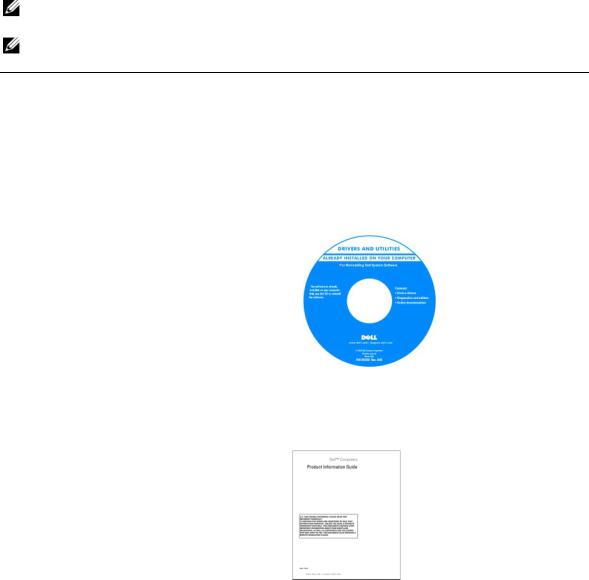
Finding Information
NOTE: Some features or media may be optional and may not ship with your computer. Some features or media may not be available in certain countries.
NOTE: Additional information may ship with your computer.
What Are You Looking For? |
Find It Here |
|
|
• A diagnostic program for my computer |
Drivers and Utilities CD (also known as ResourceCD) |
• Drivers for my computer |
NOTE: The Drivers and Utilities CD may be optional and may |
• My device documentation |
not ship with your computer. |
|
|
• Notebook System Software (NSS) |
Documentation and drivers are already installed on your |
|
computer. You can use the CD to reinstall drivers (see |
|
"Reinstalling Drivers and Utilities" in your User’s Guide) or |
|
to run the Dell Diagnostics (see "Dell Diagnostics" in your |
|
User’s Guide). |
|
Readme files may be |
|
included on your CD to |
|
provide last-minute |
|
updates about technical |
|
changes to your computer |
|
or advanced technical- |
|
reference material for |
|
technicians or experienced |
|
users. |
|
NOTE: Drivers and documentation updates can be found at |
|
support.dell.com. |
|
|
• Warranty information |
Dell™ Product Information Guide |
• Terms and Conditions (U.S. only) |
|
• Safety instructions |
|
• Regulatory information |
|
• Ergonomics information |
|
• End User License Agreement |
|
Quick Reference Guide |
5 |
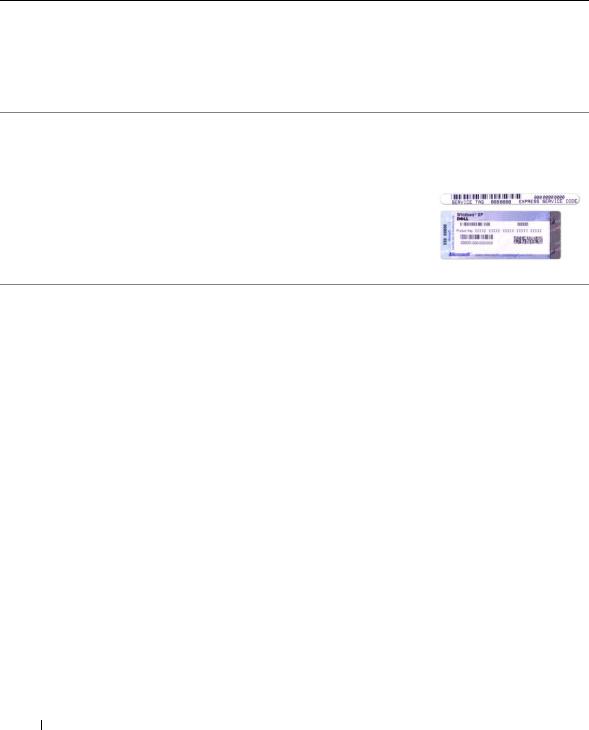
What Are You Looking For? |
Find It Here |
|
|
|
|
• How to remove and replace parts |
Dell Latitude™ User’s Guide |
|
• Specifications |
Microsoft Windows XP Help and Support Center |
|
• How to configure system settings |
1 |
Click Start→ Help and Support→ Dell User and System |
• How to troubleshoot and solve problems |
|
Guides→ System Guides. |
|
2 |
Click the User’s Guide for your computer. |
•Service Tag and Express Service Code
•Microsoft Windows License Label
Service Tag and Microsoft® Windows® License
These labels are located on the bottom of your computer.
•Use the Service Tag to identify your computer when you use support.dell.com or contact support.
• Enter the Express Service Code to direct your call when contacting support.
•Solutions — Troubleshooting hints and tips, articles from technicians, and online courses, frequently asked questions
•Community — Online discussion with other Dell customers
•Upgrades — Upgrade information for components, such as memory, the hard drive, and the operating system
•Customer Care — Contact information, service call and order status, warranty, and repair information
•Service and support — Service call status and support history, service contract, online discussions with support
•Reference — Computer documentation, details on my computer configuration, product specifications, and white papers
•Downloads — Certified drivers, patches, and software updates
•Notebook System Software (NSS)— If you reinstall the operating system for your computer, you should also reinstall the NSS utility. NSS provides critical updates
for your operating system and support for Dell™ 3.5-inch USB floppy drives, Intel® Pentium®
M processors, optical drives, and USB devices. NSS is necessary for correct operation of your Dell computer. The software automatically detects your computer and operating system and installs the updates appropriate for your configuration.
Dell Support Website — support.dell.com
NOTE: Select your region to view the appropriate support site.
To download Notebook System Software:
1 Go to support.dell.com, select your business segment, and enter your Service Tag.
2 Select Drivers & Downloads and click Go.
3 Click your operating system and search for the keyword
Notebook System Software.
NOTE: The support.dell.com user interface may vary depending on your selections.
6 Quick Reference Guide

What Are You Looking For? |
Find It Here |
|
|
|
|
• Software upgrades and troubleshooting hints |
Dell Support Utility |
|
• Frequently asked questions, hot topics, and general |
The Dell Support Utility is an automated upgrade and |
|
health of your computing environment |
notification system installed on your computer. This |
|
|
||
|
support provides real-time health scans of your computing |
|
|
environment, software updates, and relevant self-support |
|
|
information. Access the Dell Support Utility from the |
|
|
icon in the taskbar. For more information, see "Accessing the |
|
|
Dell Support Utility" in your User’s Guide. |
|
|
|
|
• How to use Windows XP |
Windows Help and Support Center |
|
• How to work with programs and files |
1 |
Click Start→ Help and Support. |
• How to personalize my desktop |
2 |
Type a word or phrase that describes your problem and |
|
|
click the arrow icon. |
|
3 |
Click the topic that describes your problem. |
|
4 |
Follow the instructions on the screen. |
•Information on network activity, the Power Management Wizard, hotkeys, and other items controlled by Dell QuickSet
Dell QuickSet Help |
|
To view Dell QuickSet Help, right-click the |
icon |
in the Microsoft® Windows® taskbar. |
|
For more information on Dell QuickSet, see "Dell™ Quickset" in your User’s Guide.
• How to reinstall my operating system |
Operating System CD |
|
NOTE: The Operating System CD may be optional and may |
|
not ship with your computer. |
|
The operating system is already installed on your computer. |
|
To reinstall your operating system, use the optional |
|
Operating System CD (see "Using the Operating System |
|
CD" in your User’s Guide). |
|
After you reinstall your |
|
operating system, use the |
|
Drivers and Utilities CD |
|
(ResourceCD) to reinstall |
|
drivers for the devices that |
|
came with your computer. |
|
NOTE: The color of your CD |
|
varies based on the |
|
operating system you |
|
ordered. |
|
|
Quick Reference Guide |
7 |

Setting Up Your Computer
CAUTION: Before you begin any of the procedures in this section, follow the safety instructions in the Product Information Guide.
1Unpack the accessories box.
2Set aside the contents of the accessories box, which you will need to complete the setup of your computer.
The accessories box also contains user documentation and any software or additional hardware (such as PC Cards, drives, or batteries) that you have ordered.
3Connect the AC adapter to the AC adapter connector on the computer and to the electrical outlet.
4Open the computer display and press the power button to turn on the computer (see "Front View" on page 9).
NOTE: It is recommended that you turn on and shut down your computer at least once before you install any cards or connect the computer to a docking device or other external device, such as a printer.
8 Quick Reference Guide
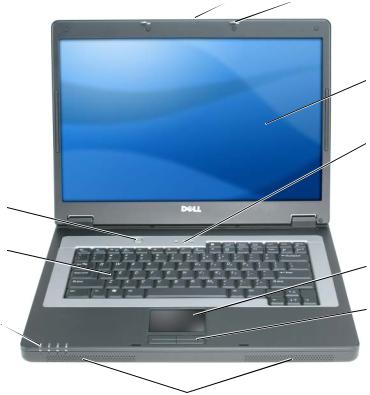
About Your Computer
Front View
 1
1  2
2
 3
3
 4
4
10
9
|
|
|
|
|
5 |
|
|
|
|
|
6 |
|
8 |
|
|
|
|
|
|
|
7 |
|
|
1 |
display latch release |
2 |
display latches (2) |
3 |
display |
4 |
keyboard status lights |
5 |
touch pad |
6 |
touch pad buttons (2) |
7 |
speakers (2) |
8 |
device status lights |
9 |
keyboard |
10 |
power button |
|
|
|
|
Quick Reference Guide |
9 |
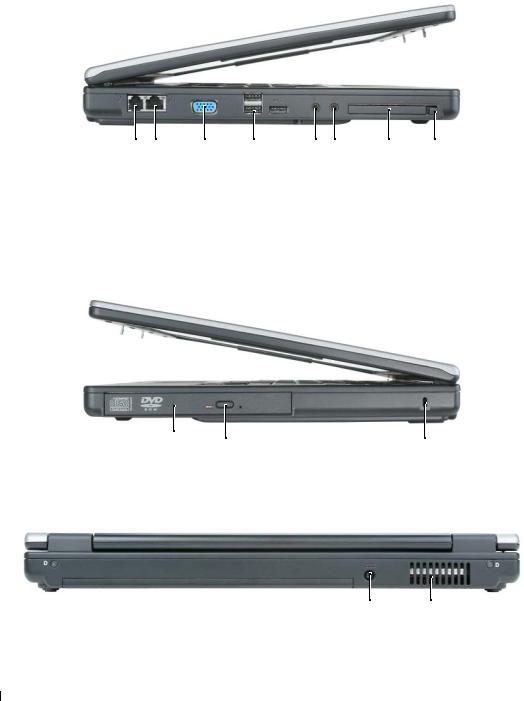
Left Side View
|
1 |
2 |
3 |
4 |
5 |
6 |
7 |
8 |
1 |
modem connector |
|
2 |
network connector |
|
|
3 |
video connector |
4 |
USB connectors (3) |
|
5 |
microphone connector |
|
6 |
headphone connector |
|
7 |
ExpressCard slot |
|
8 |
ExpressCard slot release |
|
|
|
|
|
|
|
|
button |
|
|
|
|
Right Side View
|
1 |
|
2 |
3 |
1 |
optical drive bay |
2 |
optical-drive-tray eject button 3 |
security cable slot |
Back View
1 2
1 |
AC adapter connector |
2 |
air vent |
10 Quick Reference Guide
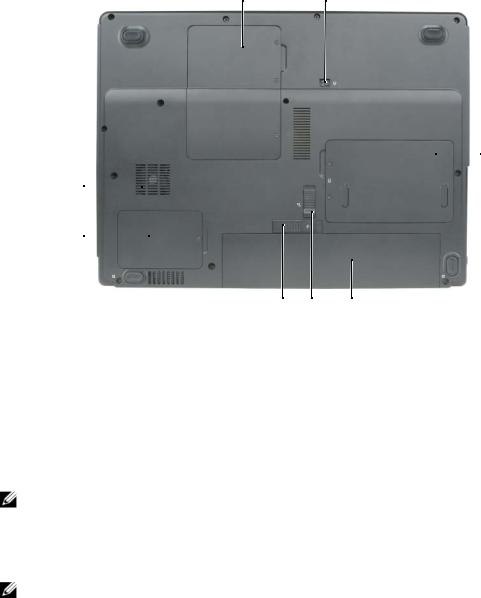
Bottom View
1 |
2 |
 3
3
8 
7 
|
|
|
6 |
5 |
4 |
|
|
1 |
memory module/Mini PCI |
2 |
optical-drive locking screw |
3 |
hard drive |
||
|
cover |
|
|
|
|
|
|
4 |
battery |
5 |
battery-bay latch lock |
|
6 |
battery-bay latch release |
|
7 |
processor and thermal module |
8 |
fan |
|
|
|
|
|
cover |
|
|
|
|
|
|
Using a Battery
Battery Performance
NOTE: For information about the Dell warranty for your computer, see the Product Information Guide or separate paper warranty document that shipped with your computer.
For optimal computer performance and to help preserve BIOS settings, operate your Dell™ portable computer with the main battery installed at all times. One battery is supplied as standard equipment in the battery bay.
NOTE: Because the battery may not be fully charged, use the AC adapter to connect your new computer to an electrical outlet the first time you use the computer. For best results, operate the computer with the AC adapter until the battery is fully charged. To view battery charge status, click Start→ Control Panel→ Power Options→ Power Meter.
Quick Reference Guide |
11 |
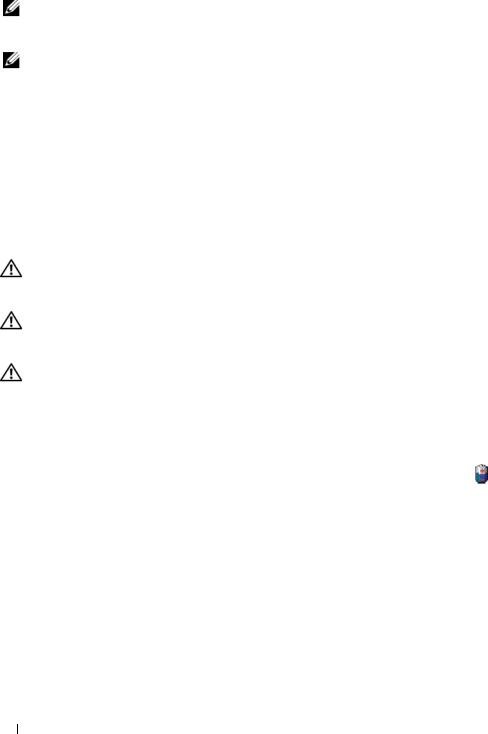
NOTE: Battery operating time (the time the battery can hold a charge) decreases over time. Depending on how often the battery is used and the conditions under which it is used, you may need to purchase a new battery during the life of your computer.
NOTE: It is recommended that you connect your computer to an electrical outlet when writing to a CD or DVD.
Battery operating time varies depending on operating conditions. Operating time is significantly reduced when you perform operations including, but not limited to, the following:
•Using optical drives
•Using wireless communications devices, PC Cards, ExpressCards, media memory cards, or USB devices
•Using high-brightness display settings, 3D screen savers, or other power-intensive programs such as 3D games
•Running the computer in maximum performance mode. See "Configuring Power Management Settings" on page 14 for information about accessing Windows Power Options Properties or Dell QuickSet, which you can use to configure power management settings.
CAUTION: Using an incompatible battery may increase the risk of fire or explosion. Replace the battery only with a compatible battery purchased from Dell. The battery is designed to work with your Dell computer. Do not use a battery from other computers with your computer.
CAUTION: Do not dispose of batteries with household waste. When your battery no longer holds a charge, call your local waste disposal or environmental agency for advice on disposing of a lithium-ion battery. See "Battery Disposal" in the Product Information Guide.
CAUTION: Misuse of the battery may increase the risk of fire or chemical burn. Do not puncture, incinerate, disassemble, or expose the battery to temperatures above 65°C (149°F). Keep the battery away from children. Handle damaged or leaking batteries with extreme care. Damaged batteries may leak and cause personal injury or equipment damage.
Checking the Battery Charge
The Dell QuickSet Battery Meter, the Microsoft Windows Power Meter window and |
icon, and the |
low-battery warning provide information on the battery charge. |
|
Dell™ QuickSet Battery Meter
If Dell QuickSet is installed, press <Fn><F3> to display the QuickSet Battery Meter. The Battery Meter displays status, battery health, charge level, and charge completion time for the battery in your computer.
For more information about QuickSet, right-click the  icon in the taskbar, and click Help.
icon in the taskbar, and click Help.
Microsoft® Windows® Power Meter
The Windows Power Meter indicates the remaining battery charge. To check the Power Meter, doubleclick the  icon on the taskbar.
icon on the taskbar.
If the computer is connected to an electrical outlet, a  icon appears.
icon appears.
12 Quick Reference Guide

Low-Battery Warning
NOTICE: To avoid losing or corrupting data, save your work immediately after a low-battery warning. Then connect the computer to an electrical outlet. If the battery runs completely out of power, hibernate mode begins automatically.
A pop-up window warns you when the battery charge is approximately 90 percent depleted. The computer enters hibernate mode when the battery charge is at a critically low level.
You can change the settings for the battery alarms in QuickSet or the Power Options Properties window. See "Configuring Power Management Settings" on page 14 for information about accessing QuickSet or the Power Options Properties window.
Conserving Battery Power
Perform the following actions to conserve battery power:
•Connect the computer to an electrical outlet when possible because battery life is largely determined by the number of times the battery is used and recharged.
•Place the computer in standby mode or hibernate mode when you leave the computer unattended for long periods of time (see "Power Management Modes" on page 13).
•Use the Power Management Wizard or the Power Options Properties window to select options to optimize your computer’s power usage. These options can also be set to change when you press the power button, close the display, or press <Fn><Esc>.
NOTE: See "Configuring Power Management Settings" on page 14 for information on conserving battery power.
Power Management Modes
Standby Mode
Standby mode conserves power by turning off the display and the hard drive after a predetermined period of inactivity (a time-out). When the computer exits standby mode, it returns to the same operating state it was in before entering standby mode.
NOTICE: If your computer loses AC and battery power while in standby mode, it may lose data.
To enter standby mode:
•Click Start→ Shut Down→ Stand by. or
•Depending on how you set the power management options in the Power Options Properties window or the QuickSet Power Management Wizard, use one of the following methods:
–Press the power button.
–Close the display.
–Press <Fn><Esc>.
Quick Reference Guide |
13 |

To exit standby mode, press the power button or open the display, depending on how you set the power management options. You cannot make the computer exit standby mode by pressing a key or touching the touch pad.
Hibernate Mode
Hibernate mode conserves power by copying system data to a reserved area on the hard drive and then completely turning off the computer. When the computer exits hibernate mode, it returns to the same operating state it was in before entering hibernate mode.
NOTICE: You cannot remove devices or undock your computer while your computer is in hibernate mode.
Your computer enters hibernate mode if the battery charge level becomes critically low.
To manually enter hibernate mode:
•Click Start→ Shut Down→ Hibernate. or
•Depending on how you set the power management options in the Power Options Properties window or the QuickSet Power Management Wizard, use one of the following methods to enter hibernate mode:
–Press the power button.
–Close the display.
–Press <Fn><Esc>.
NOTE: Some PC Cards or ExpressCards may not operate correctly after the computer exits hibernate mode. Remove and reinsert the card (see "Removing a Card or Blank in your User’s Guide), or simply restart (reboot) your computer.
To exit hibernate mode, press the power button. The computer may take a short time to exit hibernate mode. You cannot make the computer exit hibernate mode by pressing a key or touching the touch pad. For more information on hibernate mode, see the documentation that came with your operating system.
Configuring Power Management Settings
You can use the QuickSet Power Management Wizard or Windows Power Options Properties to configure the power management settings on your computer.
•For more information about QuickSet, right-click the  icon in the taskbar and click Help.
icon in the taskbar and click Help.
•To access the Power Options Properties window, click Start→ Control Panel→ Power Options. For information on any field in the Power Options Properties window, click the question mark icon on the title bar and then click on the area where you need information.
14 Quick Reference Guide

Charging the Battery
NOTE: When the computer is turned off, the AC adapter charges a completely discharged battery to 80 percent in about 1 hour and to 100 percent in approximately 2 hours. Charge time is longer with the computer turned on. You can leave the battery in the computer for as long as you like. The battery’s internal circuitry prevents the battery from overcharging.
When you connect the computer to an electrical outlet or install a battery while the computer is connected to an electrical outlet, the computer checks the battery charge and temperature. If necessary, the AC adapter then charges the battery and maintains the battery charge.
If the battery is hot from being used in your computer or being in a hot environment, the battery may not charge when you connect the computer to an electrical outlet.
The battery is too hot to start charging if the  light flashes alternately green and orange. Disconnect the computer from the electrical outlet and allow the computer and the battery to cool to room temperature. Then connect the computer to an electrical outlet to continue charging the battery.
light flashes alternately green and orange. Disconnect the computer from the electrical outlet and allow the computer and the battery to cool to room temperature. Then connect the computer to an electrical outlet to continue charging the battery.
For more information about resolving problems with a battery, see "Power Problems" in your User’s Guide.
Replacing the Battery
CAUTION: Using an incompatible battery may increase the risk of fire or explosion. Replace the battery only with a compatible battery purchased from Dell. The battery is designed to work with your Dell™ computer. Do not use a battery from other computers with your computer.
CAUTION: Before performing these procedures, turn off the computer, disconnect the AC adapter from the electrical outlet and the computer, disconnect the modem from the wall connector and computer, and remove any other external cables from the computer.
NOTICE: You must remove all external cables from the computer to avoid possible connector damage.
Quick Reference Guide |
15 |
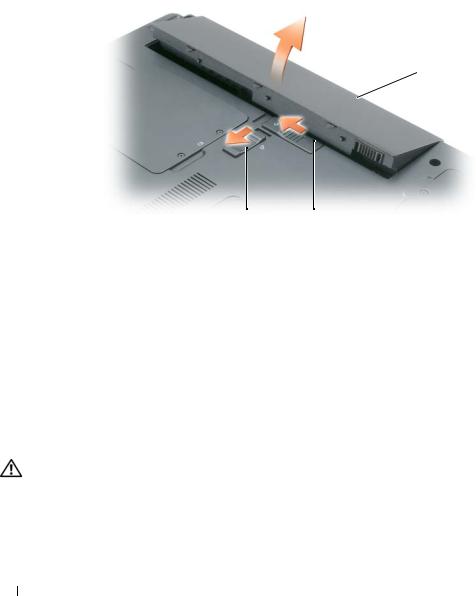
To remove the battery:
1If the computer is connected to a docking device (docked), undock it. See the documentation that came with your docking device for instructions.
2Ensure that the computer is turned off.
3Slide the battery-bay latch lock on the bottom of the computer away from the battery.
4Slide and hold the battery-bay latch release, and then remove the battery from the bay.
 1
1
3 2
1 battery |
2 |
battery-bay latch release |
3 |
battery-bay latch lock |
To replace the battery, follow the removal procedure in reverse order.
Storing a Battery
Remove the battery when you store your computer for an extended period of time. A battery discharges during prolonged storage. After a long storage period, recharge the battery (see "Charging the Battery" on page 15) fully before you use it.
Troubleshooting
Lockups and Software Problems
CAUTION: Before you begin any of the procedures in this section, follow the safety instructions in the Product Information Guide.
16 Quick Reference Guide

The computer does not start up
ENSURE THAT THE AC ADAPTER IS FIRMLY CONNECTED TO THE COMPUTER AND TO THE ELECTRICAL OUTLET.
The computer stops responding
NOTICE: You might lose data if you are unable to perform an operating system shutdown.
— If you are unable to get a response by pressing a key on your keyboard or moving your mouse, press and hold the power button for at least 8 to 10 seconds until the computer turns off. Then restart your computer.
A program stops responding or crashes repeatedly
NOTE: Software usually includes installation instructions in its documentation or on a floppy disk or CD.
END THE PROGRAM —
1Press <Ctrl><Shift><Esc> simultaneously and click Task Manager.
2Click the program that is no longer responding and click End Task.
CHECK THE SOFTWARE DOCUMENTATION — If necessary, uninstall and then reinstall the program.
A program is designed for an earlier Microsoft® Windows® operating system
RUN THE PROGRAM COMPATIBILITY WIZARD — The Program Compatibility Wizard configures a program so it runs in an environment similar to non-Windows XP operating system environments.
1Click Start→ All Programs→ Accessories→ Program Compatibility Wizard.
2Click Next and follow the instructions on the screen.
A solid blue screen appears
TURN THE COMPUTER OFF — If you are unable to get a response by pressing a key on your keyboard or moving your mouse, press and hold the power button for at least 8 to 10 seconds until the computer turns off. Then restart your computer.
Other software problems
CHECK THE SOFTWARE DOCUMENTATION OR CONTACT THE SOFTWARE MANUFACTURER FOR TROUBLESHOOTING INFORMATION —
•Ensure that the program is compatible with the operating system installed on your computer.
•Ensure that your computer meets the minimum hardware requirements needed to run the software. See the software documentation for information.
•Ensure that the program is installed and configured properly.
•Verify that the device drivers do not conflict with the program.
•If necessary, uninstall and then reinstall the program.
Quick Reference Guide |
17 |

BACK UP YOUR FILES IMMEDIATELY.
USE A VIRUS-SCANNING PROGRAM TO CHECK THE HARD DRIVE, FLOPPY DISKS, OR CDS.
SAVE AND CLOSE ANY OPEN FILES OR PROGRAMS AND SHUT DOWN YOUR COMPUTER THROUGH THE START MENU.
SCAN THE COMPUTER FOR SPYWARE — If you are experiencing slow computer performance, you frequently receive pop-up advertisements, or you are having problems connecting to the Internet, your computer might be infected with spyware. Use an anti-virus program that includes anti-spyware protection (your program may require an upgrade) to scan the computer and remove spyware. For more information, go to support.dell.com and search for the keyword spyware.
RUN THE DELL DIAGNOSTICS — See "Dell Diagnostics" on page 18. If all tests run successfully, the error condition is related to a software problem.
Dell Diagnostics
CAUTION: Before you begin any of the procedures in this section, follow the safety instructions in the Product Information Guide.
When to Use the Dell Diagnostics
If you experience a problem with your computer, perform the checks in "Lockups and Software Problems" on page 16 and run the Dell Diagnostics before you contact Dell for technical assistance.
It is recommended that you print these procedures before you begin.
NOTICE: The Dell Diagnostics works only on Dell™ computers.
NOTE: The Drivers and Utilities CD is optional and may not ship with your computer.
Start the Dell Diagnostics from either your hard drive or from the Drivers and Utilities CD (also known as the ResourceCD).
Starting the Dell Diagnostics From Your Hard Drive
The Dell Diagnostics is located on a hidden diagnostic utility partition on your hard drive.
NOTE: If your computer cannot display a screen image, contact Dell (see "Contacting Dell" in your User’s Guide).
1Shut down the computer.
2If the computer is connected to a docking device (docked), undock it. See the documentation that came with your docking device for instructions.
3Connect the computer to an electrical outlet.
4Diagnostics can be invoked one of two ways:
a Turn on the computer. When the DELL™ logo appears, press <F12> immediately. Select Diagnostics from the boot menu and press <Enter>.
NOTE: If you wait too long and the operating system logo appears, continue to wait until you see the Microsoft® Windows® desktop. Then shut down your computer and try again.
18 Quick Reference Guide

b Press and hold the <Fn> key while starting the computer.
NOTE: If you see a message stating that no diagnostics utility partition has been found, run the Dell Diagnostics from the Drivers and Utilities CD.
The computer runs the Pre-boot System Assessment, a series of initial tests of your system board, keyboard, hard drive, and display.
•During the assessment, answer any questions that appear.
•If a failure is detected, the computer stops and beeps. To stop the assessment and restart the computer, press <Esc>; to continue to the next test, press <y>; to retest the component that failed, press <r>.
•If failures are detected during the Pre-boot System Assessment, write down the error code(s) and contact Dell (see "Contacting Dell" in your User’s Guide).
If the Pre-boot System Assessment completes successfully, you receive the message Booting Dell Diagnostic Utility Partition. Press any key to continue.
5 Press any key to start the Dell Diagnostics from the diagnostics utility partition on your hard drive.
Starting the Dell Diagnostics From the Drivers and Utilities CD
1Insert the Drivers and Utilities CD.
2Shut down and restart the computer.
When the DELL logo appears, press <F12> immediately.
If you wait too long and the Windows logo appears, continue to wait until you see the Windows desktop. Then shut down your computer and try again.
NOTE: The next steps change the boot sequence for one time only. On the next start-up, the computer boots according to the devices specified in the system setup program.
3When the boot device list appears, highlight CD/DVD/CD-RW Drive and press <Enter>.
4Select the Boot from CD-ROM option from the menu that appears and press <Enter>.
5Type 1 to start the menu and press <Enter> to proceed.
6Select Run the 32 Bit Dell Diagnostics from the numbered list. If multiple versions are listed, select the version appropriate for your computer.
7When the Dell Diagnostics Main Menu appears, select the test you want to run.
Quick Reference Guide |
19 |
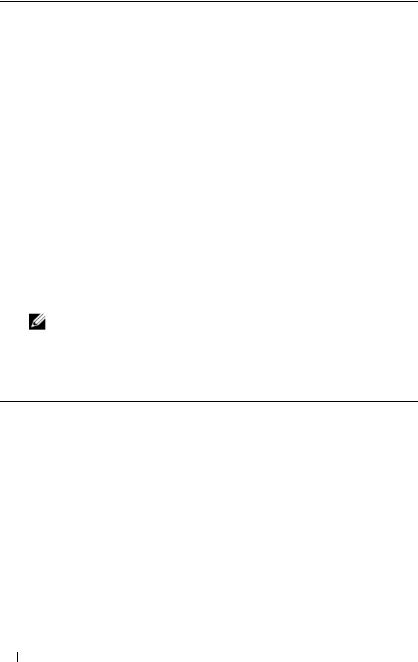
Dell Diagnostics Main Menu
1After the Dell Diagnostics loads and the Main Menu screen appears, click the button for the option you want.
Option |
Function |
|
|
Express Test |
Performs a quick test of devices. This test typically takes |
|
10 to 20 minutes and requires no interaction on your |
|
part. Run Express Test first to increase the possibility of |
|
tracing the problem quickly. |
|
|
Extended Test |
Performs a thorough check of devices. This test typically |
|
takes 1 hour or more and requires you to answer |
|
questions periodically. |
|
|
Custom Test |
Tests a specific device. You can customize the tests you |
|
want to run. |
|
|
Symptom Tree |
Lists the most common symptoms encountered and |
|
allows you to select a test based on the symptom of the |
|
problem you are having. |
|
|
2If a problem is encountered during a test, a message appears with an error code and a description of the problem. Write down the error code and problem description and follow the instructions on the screen.
If you cannot resolve the error condition, contact Dell (see "Contacting Dell" in your User’s Guide).
NOTE: The Service Tag for your computer is located at the top of each test screen. If you contact Dell, technical support will ask for your Service Tag.
3If you run a test from the Custom Test or Symptom Tree option, click the applicable tab described in the following table for more information.
Tab |
Function |
|
|
Results |
Displays the results of the test and any error conditions |
|
encountered. |
|
|
Errors |
Displays error conditions encountered, error codes, and |
|
the problem description. |
|
|
Help |
Describes the test and may indicate requirements for |
|
running the test. |
20 Quick Reference Guide

Tab |
Function |
|
|
Configuration |
Displays your hardware configuration for the selected |
|
device. |
|
The Dell Diagnostics obtains configuration information |
|
for all devices from system setup, memory, and various |
|
internal tests, and it displays the information in the |
|
device list in the left pane of the screen. The device list |
|
may not display the names of all the components |
|
installed on your computer or all devices attached to your |
|
computer. |
|
|
Parameters |
Allows you to customize the test by changing the test |
|
settings. |
|
|
4When the tests are completed, if you are running the Dell Diagnostics from the Drivers and Utilities CD, remove the CD.
5When the tests are complete, close the test screen to return to the Main Menu screen. To exit the Dell Diagnostics and restart the computer, close the Main Menu screen.
Quick Reference Guide |
21 |

22 Quick Reference Guide

Index
A
anti-virus software, 18
anti-virus software, 18
B
battery charging, 15
checking the charge, 12 conserving power, 13 operating time, 12 performance, 11 power meter, 12 removing, 15 replacing, 15
storing, 16
C
CDs
Drivers and Utilities, 5
Operating System, 7
ResourceCD, 5
computer back view, 10
bottom view, 11 crashes, 17 documentation, 6-7
computer (continued) front view, 9
setting up, 8 side views, 10
slow performance, 18 stops responding, 17
D
Dell Diagnostics main menu, 20
starting from Drivers and Utilities CD, 19
starting from hard drive, 18 using, 18
Dell support site, 6
documentation End User License
Agreement, 5 ergonomics, 5 online, 6
Product Information Guide, 5 regulatory, 5
safety, 5
User’s Guide, 6 warranty, 5
drivers
Drivers and Utilities CD, 5
Drivers and Utilities CD
Dell Diagnostics, 19
E
End User License
Agreement, 5
ergonomics information, 5
H
hard drive
Dell Diagnostics, 18
hardware
Dell Diagnostics, 18
Help and Support Center, 6-7
help file QuickSet, 7
Windows Help and Support Center, 7
hibernate mode, 14
L
labels
Microsoft Windows, 6 Service Tag, 6, 20
O
operating system reinstalling, 7
Operating System CD, 7
Index 23

P
power
hibernate mode, 14 management settings, 14 standby mode, 13
problems
blue screen, 17 computer crashes, 17
computer does not start up, 17 computer stops responding, 17 Dell Diagnostics, 18
lockups, 16 program crashes, 17
program stops responding, 17 programs and Windows
compatibility, 17 slow computer
performance, 18 software, 16-17 solving, 16
spyware, 18
Product Information Guide, 5
Q
QuickSet Help, 7
R
regulatory information, 5
ResourceCD
Dell Diagnostics, 18
S
safety instructions, 5
Service Tag, 6
setting up computer, 8
software
notebook system, 6 problems, 17
spyware, 18
standby mode, 13
support website, 6
T
troubleshooting Dell Diagnostics, 18
Help and Support Center, 7
U
User’s Guide, 6
W
warranty information, 5
Windows XP
Help and Support Center, 7 hibernate mode, 14 Program Compatibility
Wizard, 17 reinstalling, 7 standby mode, 13
wizards
Program Compatibility Wizard, 17
24 Index
Dell™ Latitude™ 120L
Snelle referentiegids
Model PP21L
w w w . d e l l . c o m | s u p p o r t . d e l l . c o m

Voor informatie over verdere documentatie die is meegeleverd met uw computer, zie "Informatie zoeken" op pagina 29.
Opmerkingen, kennisgevingen en waarschuwingen
OPMERKING: Een OPMERKING duidt belangrijke informatie aan voor een beter gebruik van de computer.
KENNISGEVING: Een KENNISGEVING duidt mogelijke beschadiging van de hardware of gegevensverlies aan en geeft aan hoe u dergelijke problemen kunt voorkomen.
 LET OP: Een WAARSCHUWING duidt het risico van schade aan eigendommen, lichamelijk letsel of overlijden aan.
LET OP: Een WAARSCHUWING duidt het risico van schade aan eigendommen, lichamelijk letsel of overlijden aan.
Afkortingen en acroniemen
Een volledige lijst met afkortingen en acroniemen vindt u in de Verklarende woordenlijst in de
Gebruikershandleiding van uw computer.
Als u een Dell™ computer uit de n-serie hebt aangeschaft, zijn de referenties in dit document naar Microsoft® Windows® -besturingssystemen niet van toepassing.
____________________
De informatie in dit document kan zonder voorafgaande kennisgeving worden gewijzigd. © 2005 Dell Inc. Alle rechten voorbehouden.
Reproductie in welke vorm dan ook zonder de schriftelijke toestemming van Dell Inc. is strikt verboden.
Handelsmerken in dit document: Dell, het DELL-logo en Latitude zijn merken van Dell Inc.; Microsoft en Windows zijn gedeponeerde merken van Microsoft Corporation; Intel en Pentium zijn gedeponeerde merken van Intel Corporation.
Andere handelsmerken en handelsnamen die mogelijk in dit document worden gebruikt, dienen ter aanduiding van de rechthebbenden met betrekking tot de merken en namen of ter aanduiding van hun producten. Dell Inc. claimt op geen enkele wijze enig eigendomsrecht ten aanzien van andere merken of handelsnamen dan haar eigen merken en handelsnamen.
Model PP21L
December 2005 |
O/N JD925 |
Rev. A00 |

Inhoud
Informatie zoeken . . . . . . . . . . . . . . . . . . . . . . . . . . . . . . . . |
29 |
Computer uitpakken en opstarten . . . . . . . . . . . . . . . . . . . . . . . . |
33 |
Over de computer . . . . . . . . . . . . . . . . . . . . . . . . . . . . . . . . |
34 |
Vooraanzicht . . . . . . . . . . . . . . . . . . . . . . . . . . . . . . . . |
34 |
Linkerzijaanzicht . . . . . . . . . . . . . . . . . . . . . . . . . . . . . . |
35 |
Rechterzijaanzicht . . . . . . . . . . . . . . . . . . . . . . . . . . . . . |
35 |
Achteraanzicht . . . . . . . . . . . . . . . . . . . . . . . . . . . . . . . |
35 |
Onderaanzicht . . . . . . . . . . . . . . . . . . . . . . . . . . . . . . . |
36 |
Batterijen gebruiken . . . . . . . . . . . . . . . . . . . . . . . . . . . . . . . |
36 |
Batterijprestatie. . . . . . . . . . . . . . . . . . . . . . . . . . . . . . . |
36 |
De lading van de batterij controleren. . . . . . . . . . . . . . . . . . . . |
37 |
De levensduur van de batterij behouden . . . . . . . . . . . . . . . . . |
38 |
Energiebeheermodi . . . . . . . . . . . . . . . . . . . . . . . . . . . . . |
38 |
Instellingen voor energiebeheer definiëren . . . . . . . . . . . . . . . . |
39 |
De batterij opladen . . . . . . . . . . . . . . . . . . . . . . . . . . . . . |
40 |
De batterij vervangen . . . . . . . . . . . . . . . . . . . . . . . . . . . . |
40 |
Een batterij opslaan. . . . . . . . . . . . . . . . . . . . . . . . . . . . . |
41 |
Problemen oplossen . . . . . . . . . . . . . . . . . . . . . . . . . . . . . . . |
41 |
Lock-ups en softwareproblemen . . . . . . . . . . . . . . . . . . . . . . |
41 |
Dell Diagnostics (Dell-diagnoseprogramma) . . . . . . . . . . . . . . . . |
43 |
Index . . . . . . . . . . . . . . . . . . . . . . . . . . . . . . . . . . . . . . . . . |
47 |
Inhoud 27

28 Inhoud
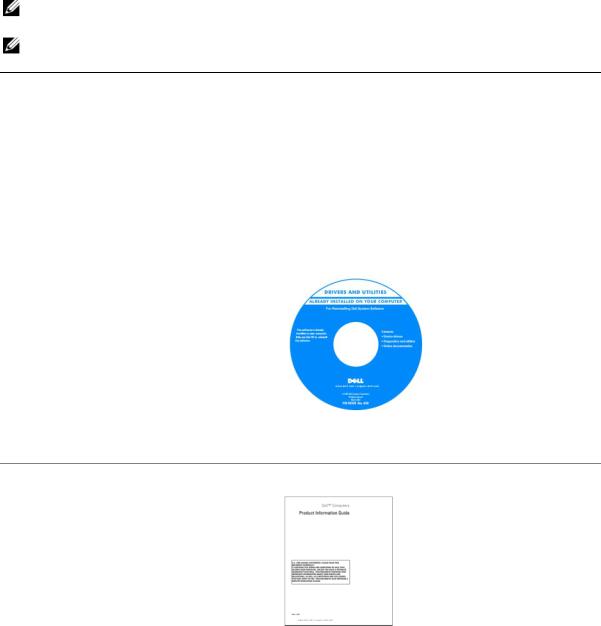
Informatie zoeken
OPMERKING: Sommige kenmerken of media zijn optioneel en het kan zijn dat ze niet zijn meegeleverd. Sommige kenmerken of media zijn niet beschikbaar in bepaalde landen.
OPMERKING: Mogelijk werd er bij uw computer bijkomende informatie geleverd.
Waar bent u naar op zoek? |
Hier kunt u het vinden |
|
|
• Een diagnoseprogramma voor de computer |
Stuuren hulpprogramma's-cd (ook wel de 'ResourceCD') |
• Drivers (Stuuren hulpprogramma's) voor mijn |
OPMERKING: De Drivers and Utilities CD (Stuuren |
computer |
hulpprogramma's-cd) kan optioneel zijn en niet geleverd met uw |
• Documentatie voor het toestel |
computer. |
|
|
• Notebook System Software (NSS) |
De documentatie en stuurprogramma's zijn reeds op de |
|
computer geïnstalleerd. U kunt de cd gebruiken om de |
|
stuurprogramma's opnieuw te installeren zie "Reinstalling |
|
Drivers and Utilities" (Opnieuw installeren van Stuuren |
|
Hulpprogramma's) in de User's Guide (gebruikershandleiding) |
|
of maak gebruik van de Dell Diagnose (zie "Dell Diagnostics" |
|
in de User's Guide (gebruikershandleiding).) |
|
Mogelijk bevat de cd leesmij- |
|
bestanden met de laatst |
|
beschikbare informatie over |
|
technische wijzigingen aan de |
|
computer of geavanceerd |
|
technisch naslagmateriaal voor |
|
technici en gevorderde |
|
gebruikers. |
OPMERKING: Bijwerkingen van de stuurprogramma's en documentatie vindt u op support.dell.com.
• Waarborg-informatie |
Dell™ Product Informatie Guide (Productinformatiegids) |
•Algemene voorwaarden (alleen Verenigde Staten)
•Veiligheidsinstructies
•Informatie over regelgeving
•Ergonomische informatie
•Licentieovereenkomst voor eindgebruikers
Snelle referentiegids |
29 |
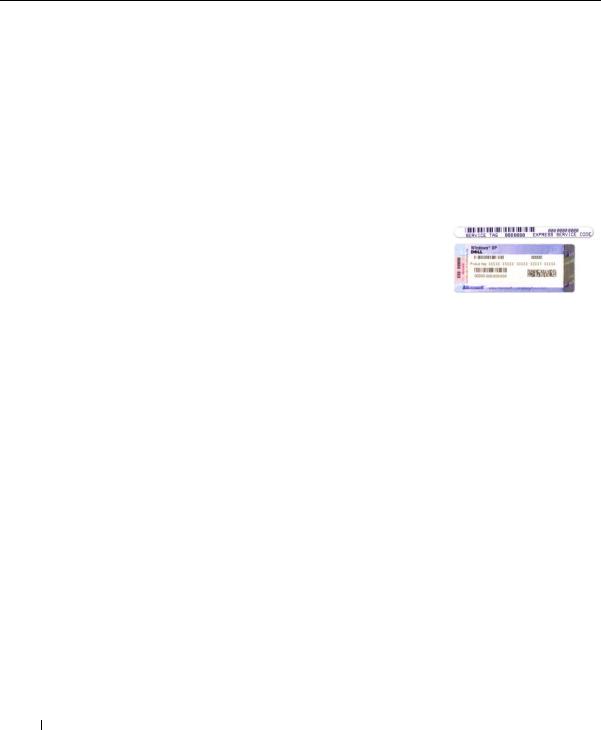
Waar bent u naar op zoek? |
Hier kunt u het vinden |
|
|
|
|
• Onderdelen verwijderen en vervangen |
Dell Latitude™ User's Guide (gebruikershandleiding) |
|
• Specificaties |
Microsoft Windows XP Help en Support Center |
|
• Systeeminstellingen configureren |
||
1 Klik op Start→ Help and Support (Hulp en Ondersteuning)→ |
||
• Problemen vaststellen en oplossen |
Dell User and System Guides (Dell Gebruikersen |
|
|
systeeminformatiehandleiding)→ System Guides |
|
|
(Systeeminformatiehandleiding). |
|
|
2 Klik op de User’s Guide (gebruikershandleiding) voor uw |
|
|
computer. |
|
|
|
|
• Servicelabel en express-servicecode |
Service Tag and Microsoft® Windows® License |
|
• Microsoft Windows-licentielabel |
Deze labels bevinden zich aan de onderzijde van de computer. |
|
|
• Gebruik de servicelabel om uw computer te identificeren als u gebruik maakt van support.dell.com of contact opneemt met de technische ondersteuning.
• Geef de exporess-servicecode als u de help desk opbelt.
30 Snelle referentiegids
